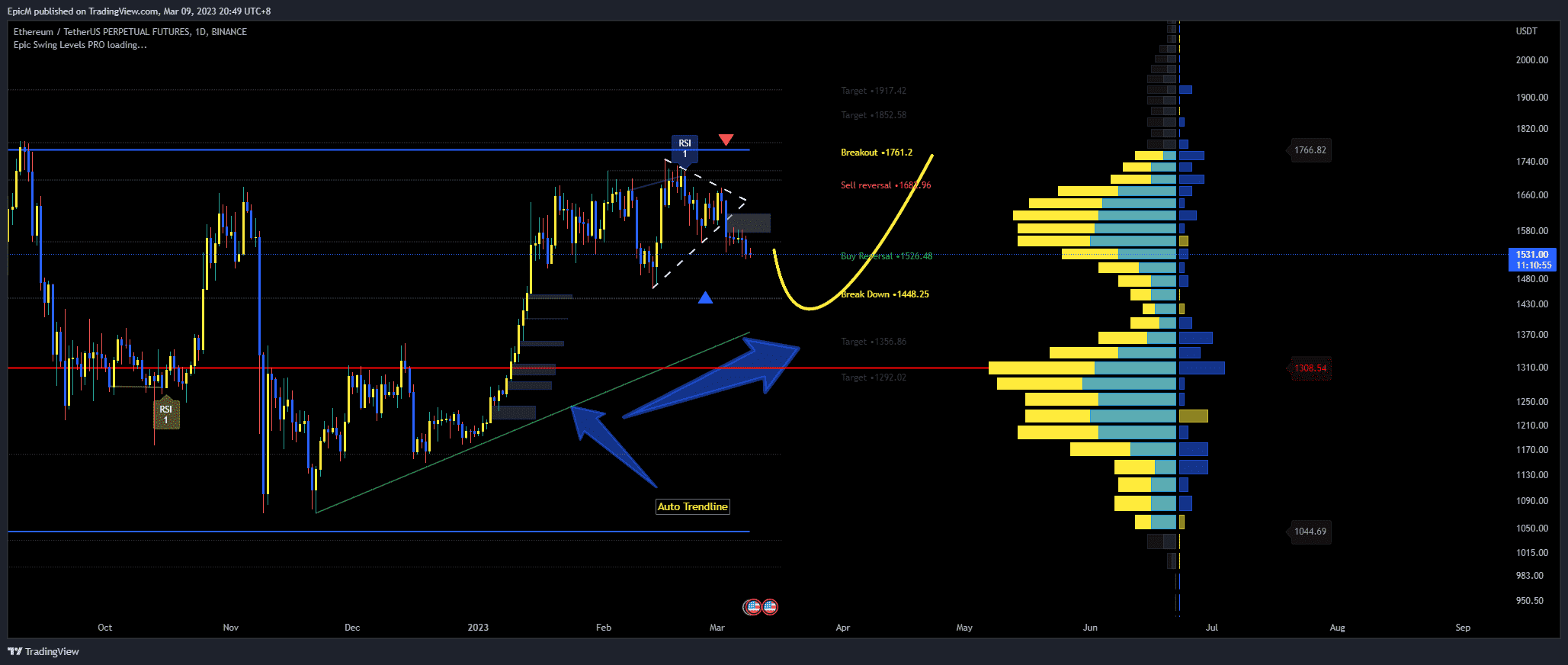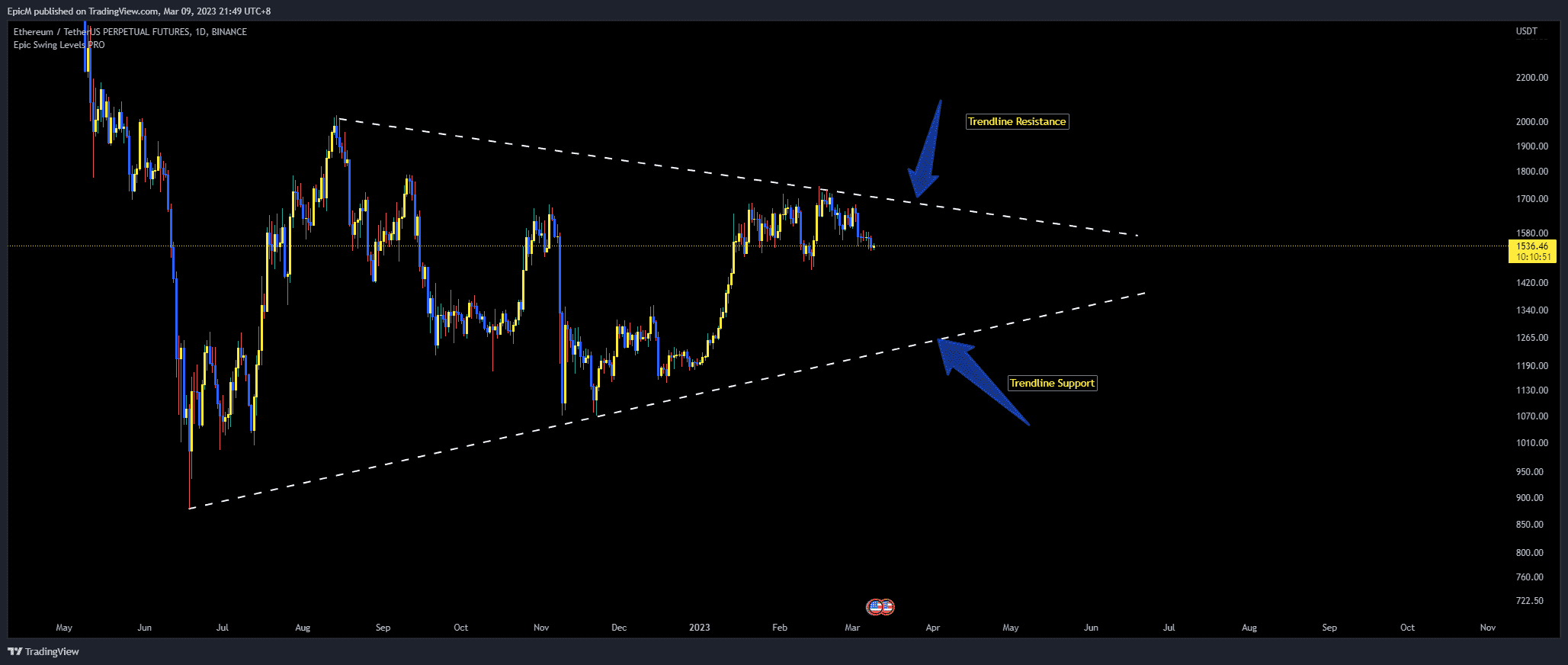The ability to illustrate trendlines on stock charts is a crucial skill for dedicated investors, and gaining knowledge on how to plot trendlines on these diagrams can considerably improve your investment approach. This task may seem challenging initially, especially for those who aren’t well-versed in technical analysis. If this describes your situation, don’t fret! This write-up will simplify the process and make it more appealing, helping you begin to use this invaluable tool swiftly.
Trendlines are an incredibly powerful indicator that allows us to make more informed decisions about when to buy and sell stocks. They provide insight into the direction of a stock’s price movements and can help us identify potential opportunities in the market. They’re relatively simple to draw once you understand the basics.
With just a few easy steps, anyone can learn how to draw trendlines on stock charts and gain a better understanding of what’s happening in the markets. In this article, we’ll take a thorough analysis into trendline analysis and teach you how to use it to your advantage. So let’s get started!
The Basics Of Trends And Why They Matter In Technical Analysis
Trends are a powerful tool in the world of technical analysis. They help investors understand the direction of the stock market, identify potential opportunities, and make educated decisions about where to invest their money. In order to use trends effectively, it is important to understand what they are and why they matter.
Think of a trend line like an arrow: It points in a certain direction and shows where prices may go next. A trend line can track the movement of stocks over time and identify potential entry or exit points for investors. The longer the trend line, the more reliable its predictions will be. Technical analysts often look at trends over longer periods of time to get a better understanding of how stocks are likely to behave in the future. By drawing accurate trend lines on stock charts, investors can gain insight into the overall direction of markets and make informed decisions about their investments.
How To Draw Accurate Trend Lines On Stock Charts
Drawing accurate trend lines on stock charts is a powerful tool for technical analysis. Trend lines are used to identify the direction of a stock’s price and to define support and resistance levels. Drawing trend lines correctly can help you expect future price movements, allowing you to make informed trading decisions. Here are 5 tips for drawing trend lines on stock charts:
- Look at the chart from multiple angles. Use different timeframes and chart types (line, bar, candlestick) to get an understanding of the overall price pattern.
- Draw trend lines that connect two or more points on the chart. The more points your trend line connects, the more reliable it will be.
- Don’t draw trend lines too close together or too far apart. If your trend line is too close, it won’t be reliable; if it’s too far apart, it will be difficult to predict where the next break or bounce may occur.
- Make sure your trend line is parallel with the price action on the chart. Avoid drawing diagonal or curved lines, as they can be unreliable in predicting future prices.
- Place stops below significant highs and above significant lows when trading with a trend line strategy. This way, you can protect yourself in case there is a sudden reversal in price direction.
By following these tips, you can ensure that the trend lines you draw on stock charts are accurate and reliable indicators of future price movements. Now that we have covered how to draw accurate trend lines on stock charts, let’s look at how we can use them to identify key support and resistance levels in our next section!
Using Trendlines To Identify Key Support And Resistance Levels
To analyze stock charts effectively, traders must be able to identify crucial support and resistance levels. These show areas where the buying or selling pressure is strong enough to affect price movements. One way to do this is by drawing trendlines that connect at least two points on a chart, which can help identify patterns of higher highs and higher lows (uptrend) or lower highs and lower lows (downtrend).
Traders can then observe when the price either bounces off the trendline or breaks through it. A bounce could signal a potential buying opportunity, while a break might show a selling opportunity. This information can be valuable for determining whether prices are overbought or oversold, helping traders make informed trading decisions.
Identifying breaks in trend lines may provide insight into impending price reversals, particularly for swing traders seeking opportunities to buy low and sell high. By monitoring trends and analyzing charts carefully, traders can hone their skills and develop a sound trading strategy that works best for them.
Identify Breaks In A Trend Line To Potentially Predict Price Reversals
To expect potential price reversals and stay informed about changes in price movements, traders and technical analysts need to identify key points on stock charts that can show shifts in trend direction. One strategy involves drawing a straight line between two or more points on the chart, usually denoting either lows for an upward trend or highs for a downward trend. This visualization tool can help investors and traders identify the direction of the trend.
One important factor to consider is looking out for areas where supply meets demand in the market. They sometimes act as support and resistance levels along the trendline. By being aware of these price points, traders can be better prepared to identify any potential reversals in price movement accurately.
In addition, breaking through support or resistance lines could signify possible reversals of stock prices. Identifying such breaks could provide an opportunity for traders to capitalize on changes in momentum by making profits through trading the potentially shifted direction of the stock.
Traders who analyze charts using these techniques will need to consider different time frames to understand whether prices will continue trending upwards or downwards, while minimizing risks associated with their trades.
What is the Relationship Between Drawing Trend Lines and Identifying Double Bottom Patterns in Trading?
Drawing trend lines is a crucial aspect of identifying and mastering the double bottom pattern in trading. Trend lines give traders a visual representation of the prevailing trend, while double bottom patterns signify potential opportunities for a bullish reversal. By carefully drawing trend lines and analyzing the price action within the channel formed, traders can confidently identify and capitalize on the double bottom pattern. Understanding this relationship is instrumental in successful trading.
Incorporating Networked Trends Into Your Trading Strategies
The ability to identify and draw trendlines on a stock chart is essential for any successful trader. By using trendlines, traders can identify support or resistance levels in the market, which can help them develop a trading strategy that takes advantage of price movements. Networked trends can also provide additional insight into the direction of the market, allowing traders to make better-informed decisions for their investments.
I derived networked trends from data points connected by lines, which form a visual pattern that can forecast future price movements. By recognizing these patterns, traders can gain insight into potential market shifts and use this information to inform their trading strategies. For example, if a networked trend shows prices are likely to move upwards soon, then traders may enter long positions in anticipation of a price rally.
Alternatively, if prices appear set to fall, traders may consider shorting stocks in order to take advantage of the downturn. In either case, understanding how networked trends work can help investors make profitable trades.
Frequently Asked Questions
How Much Capital Do I Need To trade Stocks?
Trading stocks can be a daunting prospect, especially if you have little capital. It’s important to ask yourself how much money you need in order to get started, as this will depend on the investments you want to make. The amount of capital you require will also determine which brokers you should use and the strategies that are available to you.
When deciding how much capital you need to trade stocks, there are a few factors that come into play. First, your risk tolerance–how much risk are you willing to take when investing? second, your budget–what is the maximum amount of money you’re willing and able to invest? Third, the type of investment product–do you want to buy individual stocks or start trading options or futures? Finally, the broker–which broker offers the best services for your needs?
Answering these questions will help determine how much capital is required for stock trading and ensure that your investment strategy is tailored for your goals. It’s also worth researching different brokers and understanding their fees and commissions before deciding. With careful planning and research, it’s possible to trade with limited funds while still achieving good returns.
What Other Indicators Should I Look At When Analyzing Stocks?
For analyzing stocks, trendlines are a great place to start. But there’s more to stock analysis than just drawing lines on charts. To truly understand the markets and make informed trading decisions, you also need to look at other indicators. These can help you spot new opportunities and identify potential risks that you may have missed with only trendline analysis.
There are many indicators that are used in stock analysis, but some of the most important ones include volume, liquidity, and volatility. Volume is the total number of shares traded in a particular period. Liquidity measures how easily the security can be bought or sold without significantly affecting the price. Finally, volatility is a measure of how much a stock’s price moves.–high volatility shows more price movements and more risk for investors.
By combining trendline analysis with these other indicators, you can get a better understanding of market activity and make better trading decisions. This approach requires more research and understanding, but it will pay off in the long run with more profitable trades.
Is It Possible To Make Money From Trading Stocks?
Yes, it is possible to make money from trading stocks! But it takes skill and knowledge to do it safely and effectively. It’s important to understand the different investments available, their risks, and the strategies that are used for successful stock trading. You need to learn about technical analysis, chart reading, indicators, and more.
When analyzing stocks, you want to look at how a stock has performed historically and its current price trends. You also want to be aware of any news or events that could influence the stock’s future performance. By doing this research, you can make informed decisions about when to enter or exit positions in order to maximize your profits. You might use financial software or online tools to monitor stocks and making trades.
Ultimately, with dedication and practice, you can become a successful trader of stocks in the markets. However, keep in mind that there are risks involved with any kind of investment, so it is important to educate yourself before investing real money in the markets.
What Kind Of Risk Is Associated With Trading Stocks?
Trading stocks is a high-stakes game, and it can seem like a risky business to get involved in. But what kind of risk are we actually talking about? As an investor, it’s important to understand the risks associated with trading stocks if you want to maximize your chances of success.
When trading stocks, there are two main types of risk: market risk and individual stock risk. Market risk refers to the overall volatility of the stock market and is affected by economic and geopolitical factors. Individual stock risk involves the performance of specific stocks or sectors, which can be influenced by company events or industry trends. Both types of risk can affect your investment returns.
It’s also important to consider other risks such as liquidity risk (the ability to buy or sell quickly), interest rate risk (when interest rates go up or down), currency exchange rate risks (changes in currency values) and inflationary risks (changes in prices). Understanding these risks can help you make informed decisions about when to buy and sell stocks, as well as how much you should invest. It’s also important to create a diversified portfolio that includes both short-term investments and long-term investments so that you’re not overly exposed to any single type of risk. By taking steps like these, you can reduce your overall exposure to risk while still potentially making money from trading stocks.
How Often Should I Review My Stock Positions?
Reviewing your stock positions is an important part of trading stocks. But how often should you do it? It really depends on the type of investor you are, and what your investment goals are.
If you’re a short-term trader, then you’ll probably want to check in with your positions more often. This means looking at the chart and news for each security every day or week to make sure that nothing unexpected has happened that could affect its price. Longer-term investors may not need to review their stocks as frequently since they’re less likely to be affected by short-term market movement.
Regardless of whether you’re a short-term or long-term investor, it’s important to keep track of the overall performance of your portfolio over time so that you can make changes if needed. This can include reviewing the performance of individual securities in your portfolio, evaluating the composition of your portfolio, assessing any potential risks associated with individual holdings, and making adjustments if necessary. Doing this regularly will help ensure that your investments are working for you and helping you reach your financial goals.
Conclusion
Investing in the stock market can be a lucrative opportunity, but it comes with inherent risks that investors need to carefully evaluate. Before delving into trading stocks, it’s important to have a good understanding of the basics and ensure you have enough capital to trade. While analyzing stocks, traders should consider volume activity and monitor relevant news headlines.
Being able to identify trends is a key factor for success in the financial markets; however, recognizing potential areas of support and resistance can be challenging without proper guidance. One way traders can improve their ability to spot these potential zones is by drawing trend lines on price charts. This can help in identifying breakouts or reversals, which may lead to opportunities for buying or selling stocks.
There’s more to succeeding than simply drawing trend lines on stock charts- patience and calculated risks are crucial as well. By learning how to read stock charts and identify patterns, you’ll become better equipped to make informed decisions in your trades.
Don’t wait any longer! Start taking control of your financial future by drawing trend lines, identifying areas of support or resistance, monitoring supply and demand levels and using technical analysis tools such as diagonal or third touch methods. With some dedication, practice and perseverance over time, decision-making processes will improve increasing profits like an experienced trader!




